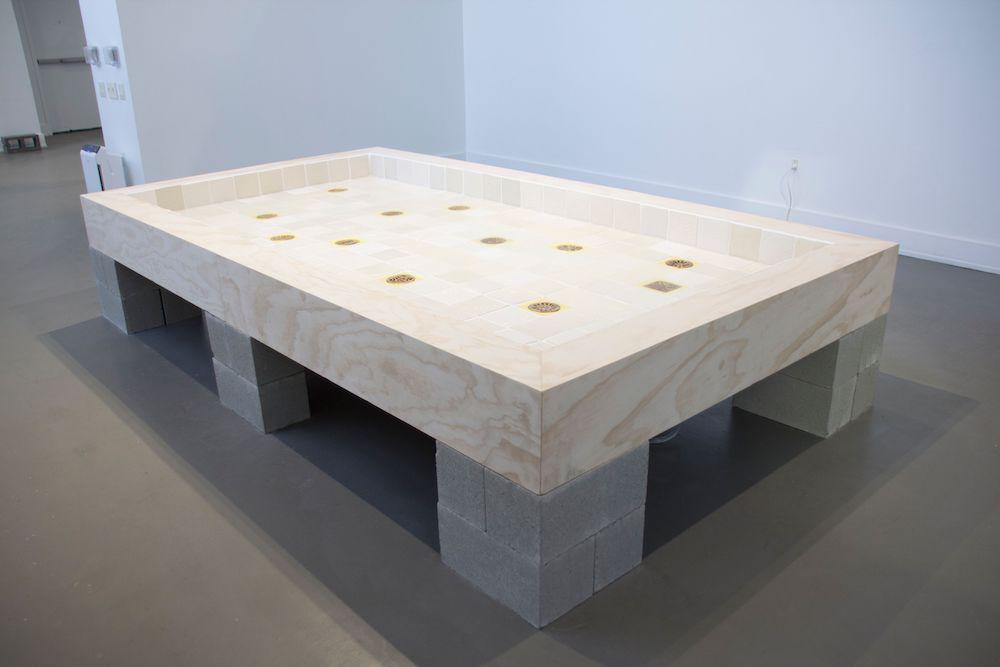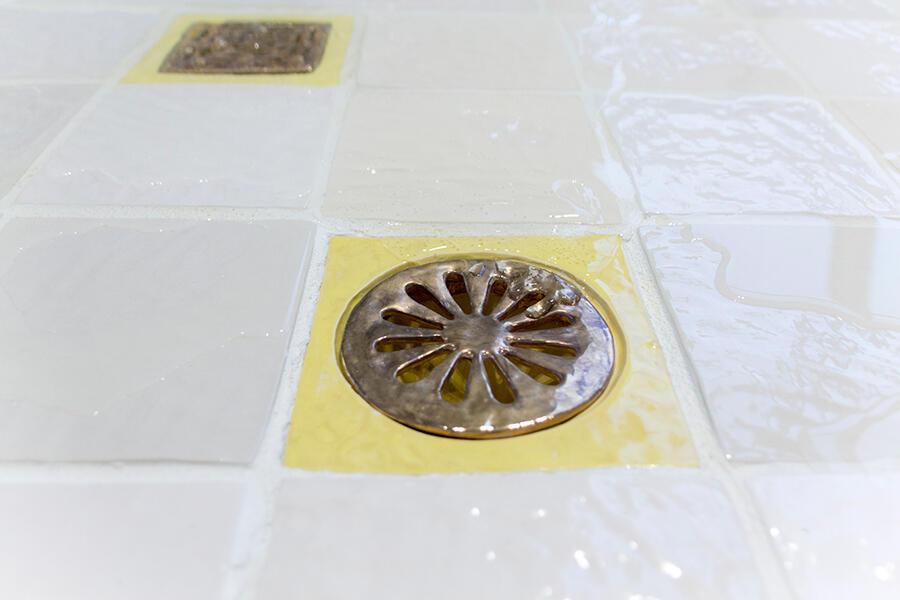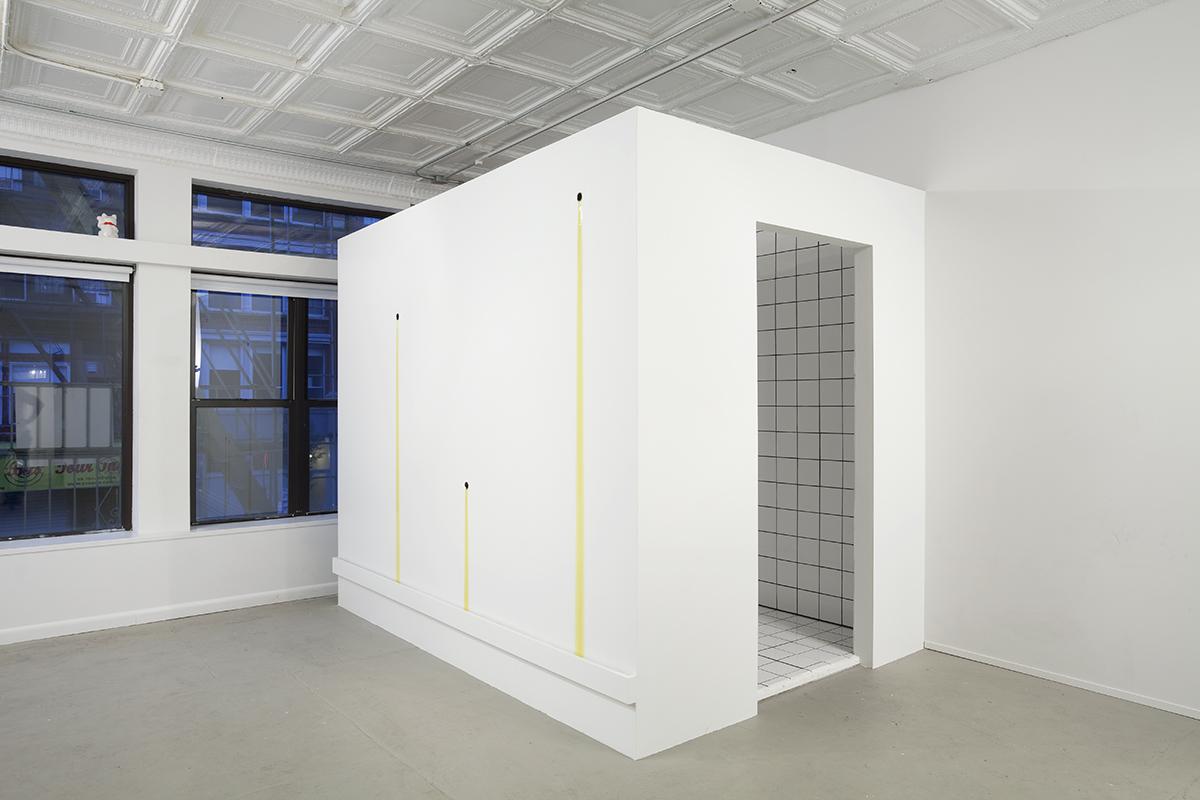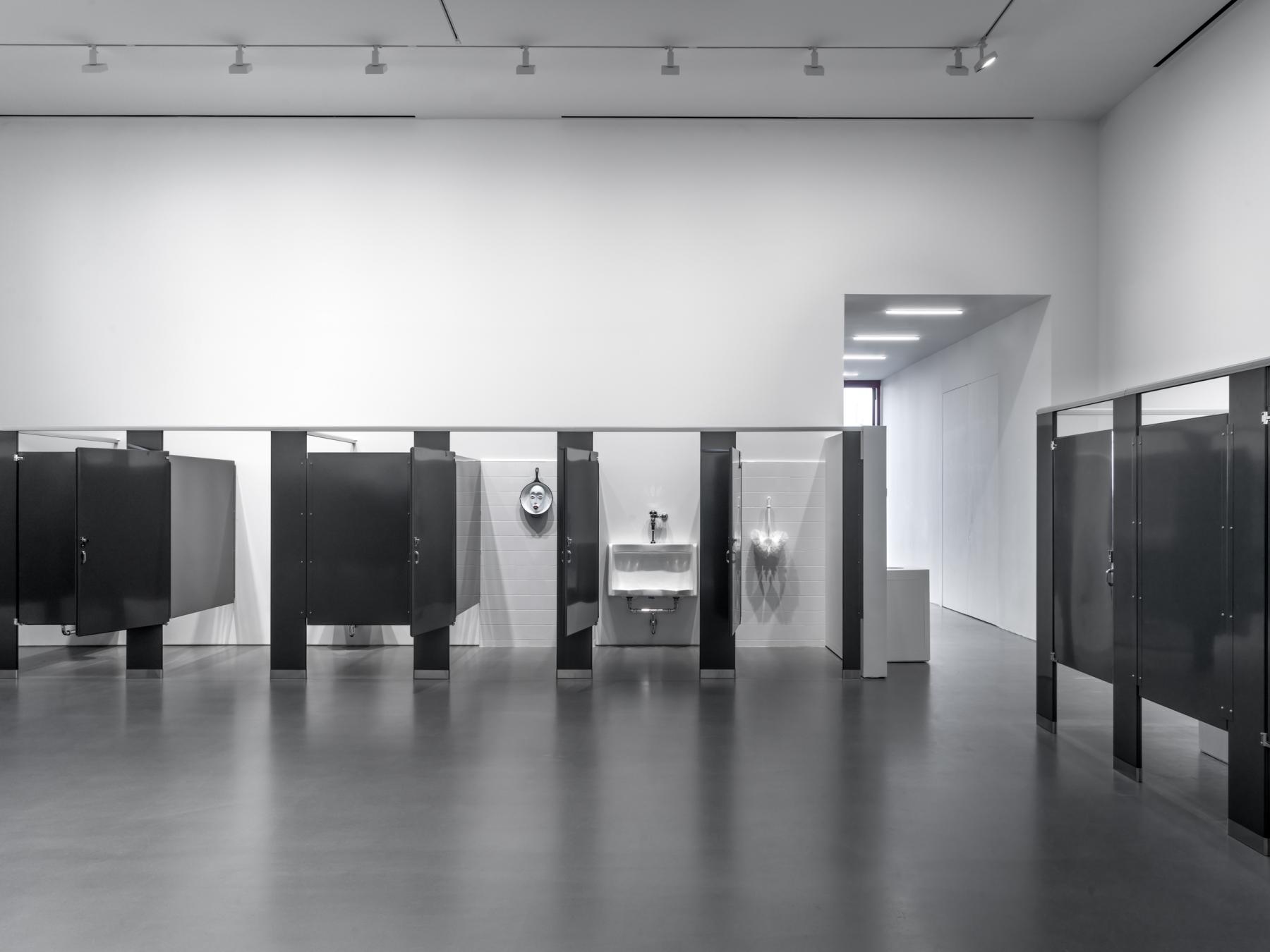.jpg)
Installation view, Hugh Hayden, Hughman, 2023–24. Lisson Gallery, Los Angeles, © Hugh Hayden. Courtesy of the artist and Lisson Gallery.
“... with each lowered and raised seat, every splash of urine, every tear of toilet paper littering the floor, the public bathroom and its plumbing point to the impossibility of keeping intimacy (the personal) out of the public realm, and of keeping the sovereign individual free of contamination.”
—Margaret Morgan1
There is no such thing as a “neutral” public restroom. From tiles to stalls, even the most seemingly banal components of these spaces are, in fact, charged technologies of social regulation. The white ceramic grids that line so many restroom walls are not merely about cleanliness, but also control. And stalls—those flimsy off-the-ground enclosures—promise privacy while delivering surveillance against the backdrop of normative whiteness.
The public restroom as we know it in Canada and the United States is the living legacy of nineteenth-century sanitary reforms in Europe. When outbreaks of cholera and tuberculosis fueled anxieties of contamination, reformers championed architecture itself as a tool of hygiene. Sweeping infrastructures were enacted to control excrement, with elaborate networks of pipes constructed to carry waste out of sight (out of mind) with just a quick flush. The prototypical modern bathroom, as the writer Mark Wigley puts it, was “a healthy and health-giving interior whose whiteness countered, revealed, and accentuated the perceived darkness of interiors, dirt, soot, excrement, polluted water, vermin, the dirty skin of workers, poverty itself, and industrialization.” White surfaces became the standard of sanitary spaces, following the logic that such unadorned materials rendered filth easy to detect and eradicate, all to keep up a pristine facade. At the behest of architects like Le Corbusier, Adolf Loos, and Hermann Muthesius, whiteness itself was soon synonymous with hygiene as a moral construct, geared towards reinforcing established social hierarchies.
It is precisely this legacy of regulation that renders public restrooms so ripe for artistic intervention. Since Duchamp’s infamous provocation a century ago, countless artists have turned to toilets, urinals, and plumbing fixtures. Here, though, I will focus on two quieter, yet no less potent motifs: the tile and the stall. These devices organize bodies within already segregated spaces, naturalizing modernist imperatives of classification. Artists such as Anicka Yi and Hugh Hayden deny the tendency to overlook these ubiquitous architectures, revealing the aesthetics of modern sanitation as a politics of exclusion. While grappling with the violent legacies of these technologies, these artists question alternative relational possibilities from the vestiges of modernity.
...there is nothing “natural” or “neutral” about the standardized fixtures of restrooms today; rather, these technologies are historically and culturally contingent, shaped by evolving social, scientific, and spiritual concepts of the body. Tiles and stalls are tactics of containment that do not merely symbolize, but actively enforce social hierarchies.
TILE
As whiteness came to symbolize material and moral purity, ceramic tile emerged as the quintessential hygienic surface. Florence Nightingale, a figurehead of the late-nineteenth-century English sanitary reform movement, even declared, “The only way to ensure dryness and cleanliness [...] is to cover the walls with white glazed tile.”2 Beyond their practical purposes, tiles projected an image of sterility, as if to disavow bodily messiness, instead shoring up patriarchal fantasies of disembodiment.
To lay tile is to enact a grid, the sanctified Modernist schema geared toward order. Tiles, as industrial units, recall the grid as a colonial instrument of control premised on the subdivision of land, labor, and bodies alike into standardized units in the relentless pursuit of rationality. The grid simultaneously maintains art historical resonances. In Rosalind Krauss’s famed essay, ‘Grids,’ she writes that the grid “functions to declare the modernity of modern art.” Anicka Yi, Cathy Lu, and Krzysztof Strzelecki—among other artists like Tishan Hsu, Adriana Varejão, and Hannah Levy3—call to reengage the legacies of the grid in the familiar form of ceramic tiles, probing at the interplay between the aesthetics of modern art and modern sanitation, with whiteness as a common denominator.
Yi plays upon the spatial dynamics of containment in Auras, Orgasms and Nervous Peaches (2011), a white, ceilingless structure lined with white tile. The gridded interior heightens the claustrophobia of the already restricted space, which is reminiscent of a commercial kitchen, an interrogation cell, a hospital room, a cubicle, and a public toilet—all regulatory sites of white patriarchal authority which shaped Modern sanitary protocols persisting today. Each tile is a white cube within the white cube that is the architectural installation within the white cube that is the modernist archetype of the gallery as an aesthetic enclave, a sort of vacuum or bubble somehow separate from the wider world. The overwhelming whiteness of this structure, which evokes what historian Fabiola López-Durán terms the “clinical agenda of architectural modernism,” prompts reckoning with the ideological underpinnings of the gallery—in its pervasive whiteness—as a non-neutral space.
The tactile familiarity of the tile here undermines the grid’s pretense of autonomy as an “antinatural, antimimetic, antireal”4 phenomenon. By inviting viewers inside this structure, Yi denies the detached gaze of modernism, while evincing the potential to reconfigure the spatial conditions of the grid, complicating distinctions between figure and ground, subject and object, viewer and artwork. Simultaneously, Yi undermines the integrity of the grid through the intimation of mess. Dirt gathers in the crevices of this modernist framework, evoking the omnipresent threat of disorder lurking within such mechanisms of order.
The pristine white facade of the structure is likewise disrupted by viscous yellow fluid that endlessly leaks through three metal spouts. With the titular mention of “orgasms,” these glossy secretions cultivate a multi-sensorial encounter heightened by the faint smell of the mystery substance—olive oil—which might simultaneously activate taste buds. This olfactory element invites thinking beyond the grid as an optical format, while denying deodorization as a mechanism of modernization, where “scent is often a marker of racial excess—the presence of something against the absence of whiteness.”5
The suggestion of leakage, or maybe even incontinence, further intimates excess in contrast to the rigid geometry of the tiles. Yi thus channels the kernels of queer transgression latent within the authoritative scaffolding of the grid, pushing back against fantasies of ultimate bodily containment through engineered “solutions.” An exhibition review describing the installation as “equal parts bathhouse and torture chamber” exemplifies the tense imbrication of pleasure and trauma crystallized through the ceramic grid, like the public restroom itself.
Where Yi compromises the grid through leakage, Cathy Lu undermines the grid through tactility. The California-based artist hand-pressed porcelain tiles in shades of off-white, tan, and yellow to form the basin of Drains (2022), a shallow sink-like installation. Subtle indentations in the glazed squares recall the embodied process of sculpting, indexing the labor of the artist and her assistants. The receptacle includes twelve painted porcelain drains modeled after ornate covers that Lu found while visiting Jingdaezhen, the famed Chinese ceramics hub. Through these decorative drains—which contrast the norm in the United States, where austerity reigns and grates are typically designed to disappear—Lu underscores the cultural and historical contingency of the design of sanitaryware.6
Lu conjures the particular diasporic resonances of mundane phenomena like tiles and drains as liminal symbols embodying the weaponization of hygiene as a racialized construct. By foregrounding the materiality of the porcelain tiles through the simplified structure of the grid, Lu implicitly evokes the irony of Euro-Western regimes of sanitation—long indebted to Chinese material traditions—that continuously target Chinese and other non-white subjects. In the context of the Covid-19 pandemic, on display at the Chinese Cultural Center of San Francisco, Drains speaks to the surge of anti-Asian violence fueled by racialized fears of contamination in the United States within and beyond that specific health crisis.
The varied shades of the tiles complicate the fetishization of the whiteness of porcelain, while suggesting the potential to enact difference, imagining the grid as an associative constellation rather than a universalizing structure. The shade of each tile is perceived in relation to the surrounding colors within a network that resists homogeneity. Simultaneously, the drains prompt envisioning the vast networks of plumbing that connect seemingly separate users across distant locales, undermining fantasies of sealed-off personal space bolstered by pristine tile surfaces. The grid here emerges as both a vestige of colonial violence and a site of potential interconnection, where washing might be a tender communal ritual.
Krzysztof Strzelecki, like Lu, invests the grid with sensual appeal by etching homoerotic scenes into handcrafted tiles. Blow, Grope, and Handjob (all 2025) each depict a sexual encounter between two men with their backs turned, in positions evoking the potential voyeurism in tile-lined spaces like public restrooms and bathhouses. By incising homoerotic fantasies into this normative substrate, Strzelecki conjures the queer desires latent within hegemonic architectures at the blurry intersection of the public and the private. The faint rendering in white on white lends a ghostly quality to the figures, as if to channel the secrecy of cruising, while underscoring the unsanctioned encounters that have long operated in such spaces of policing.
These etchings recall latrinalia (or, bathroom graffiti) as an unsanctioned method of transforming surveilled infrastructures into bulletin boards for anonymous messaging. Latrinalia transgresses the aesthetic and theoretical purity of authoritarian architectures geared toward separation rather than connection between users with their pants pulled down. With the potential for expressions of queer desire comes the potential for homophobic messaging, of course. Nonetheless, though, latrinalia derives power as a collective form of place-making that erodes hegemonic order.
The absence of grout between Strzelecki’s loosely arranged tiles suggests the flexibility of the individual units, positing the grid as a more malleable relational network. This characteristic modularity might “allow us to think beyond the register of the individual subject and to conceive a commons (rather than an equivalence) of the incommensurable, even as crisscrossing trajectories of singular being remain violent and traumatic,” as Lex Lancaster suggests.7 I’m reminded here of Lu’s installation, which likewise mobilizes the grid as a site of communion that allots for particularity. As such, both artists resist the totalizing logic of the grid as a universalizing framework, while pushing back against the ethos of individualism underlying modernist sanitary measures.
From Yi’s queering of modernist sterility to Lu’s diasporic reorientation of porcelain and Strzelecki’s eroticization of white tiles, these artists engage the grid’s repressive tendencies, while questioning the potential for alternative relational dynamics.

Cathy Lu, Drains, 2022, porcelain, gold luster, wood, cinder blocks, plastic buckets, water pumps, tubing, dimension varies. Courtesy: the Chinese Culture Center of San Francisco. Sourced via.

Cathy Lu, Drains (detail), 2022, porcelain, gold luster, wood, cinder blocks, plastic buckets, water pumps, tubing. Courtesy: the Chinese Culture Center of San Francisco. Sourced via.

Anicka Yi, Auras, Orgasms, and Nervous Peaches, 2011, three stainless steel spouts, olive oil, tile, pump. 96" x 72" x 120". Sourced via.
STALL
The logic of the grid pervades the prototypical public restroom in Canada and the United States, where stalls enact internal order. Off-the-floor partitions—which first appeared in North American factories at the turn of the twentieth century—gained popularity following Frank Lloyd Wright’s incorporation of stalls in an office building in Buffalo, New York in 1906. It’s hardly coincident that stalls emerged from this corporate context as a twin mechanism of compartmentalization with the cubicle: a prime capitalist managerial tool.
As concentric enclosures, stalls reproduce the spatial logics of segregation— historically by race, and today by sex—which ostracizes, if not outright excludes those who fail to conform to such rigid binary terms. Partitions limit contact between same-sex users in line with heterosexual norms, while serving as visual shields that obscure urination and defecation, the sort of visceral activities that rupture fantasies of the sealed-off, stable body. The illusion of privacy is tenuous—with gaps above and below partitions to enable policing of unsanctioned behavior—as sounds and smell exceed these meager barriers. As such, stalls evoke Foucault’s concept of the panopticon: a modern technology premised on the separation of individuals into discrete compartments where the constant sense of being watched encourages self-discipline. Theorist Andie Elizabeth Shabbar articulates the pervasive violence of surveillance for queer and gender-nonconforming users: stalls are “used not only to closet, and threaten to un-closet, non-normative genders but also [give] the public a sense of entitlement to interrogate and police the presence of queer gender and sexuality.”8
Juliana Huxtable situated three stalls devoid of plumbing at the center of Interfertility Industrial Complex: Snatch the Calf Back (2019), an exhibition in which the Black, trans femme artist explored the embodied dynamics of biopower by envisioning herself as a fantastical hybridized “cow-woman.” The outer two stalls featured posters of Huxtable’s neon human-bovine figure bent over in a pin up-like pose. These posters—ephemera akin to latrinalia—might suggest these stalls as semi-private enclaves of sensual activity. And yet, a voiceover from a monitor in the center unit likens the partitioned spaces to livestock enclosures, spaces of captivity.
Huxtable, recognizing how the presence of trans people in restrooms threatens to destabilize binary logics, goes a step further: her animal-human hybrid complicates speciest hierarchies, challenging human exceptionalism as the very foundation of all other social categories. In this satirical send-up of the “natural,” Huxtable confronts the exclusionary premise of supposedly universal human rights crystallized by public restrooms as sites of both the social production and policing of gender identity.
Like Huxtable, Hugh Hayden explores the tensions between desire and discipline within the regulatory scaffolding of stalls. In Hughmans (2024), the partitions choreographed the movement within Lisson Gallery’s Los Angeles space, perhaps encouraging visitors to check for feet beneath stalls before opening a door to the sculpture inside each compartment. The nervy potential of intruding on someone (or, being intruded on yourself) shaped the phenomenological experience of this installation, inviting conscious consideration of the internalized, unchecked codes of conduct governing these spaces. The stalls lent both secrecy and anticipation to the art-viewing experience, conjuring the vast array of subjective associations with public toilets: from embarrassment, disgust, and anxiety, to relief, titillation, and pleasure. The affective resonances of this installation would radically differ depending on one’s sense of belonging within such exclusionary spaces premised on white heterosexual patriarchal authority.
A gallery employee-cum-bathroom attendant invited visitors to use two functional urinals in defiance of conventional gallery etiquette. Regardless of whether a particular visitor took up this offer—a gendered offer—the invitation encouraged a heightened sense of bodily awareness. Behind one door, a urinal situated low to the ground was lined with a mirror that would double a stream of urine, heightening the spectacularity of the mundane act. Across the room, Hayden paid homage to Robert Gober with a custom double-wide urinal that encourages two (or more) users to share a stall in a dramatic reversal of partitions intended to separate same-sex users. By positioning the urinals inside the partitions, when these fixtures are typically situated in the open, Hayden invites considering the gendered implications of stalls as feminized sites of relative privacy according to binary conventions of gender.
Hayden, like Huxtable, channels the tension of stalls—where violence is entangled with desire—through his semi-readymade sculptures, which remix symbols of the so-called American Dream. A plastic gun is transformed into a phallus protruding from a tuft of hair, for example, in an assemblage referencing legacies of police brutality against Black people in the United States. Meanwhile, the incorporation of a closet likens the stall to the fabled queer architecture shaped by fraught constructs of privacy and homophobic pressures of self-categorization. The stalls, in conjunction with these charged sculptures, question how authoritarian structures mediate the most intimate everyday moments.
This site-specific installation conjured the recent history of Lisson’s building as a gay sex club, recalling an era of cruising in public and semi-public spaces before the rise of hook-up apps. However, despite the reactivation of the club’s former plumbing system, there is marked dissonance between the sterile atmosphere of the white cube gallery and that of the club. This juxtaposition perhaps lends critical edge to this intervention, though, drawing attention to the ongoing processes of real estate development, implicating Lisson within broader systems of gentrification. By importing a “men’s room” into the white cube, rather than recreating the atmosphere of the club, Hayden restructures the conventions of visibility, while questioning what intimacies are possible within a city lacking accessible public toilets and sanctioned spaces of gay sociality. Together, both Hayden and Huxtable—like other artists including Alex Schweder, Michael Blake, Emmett Ramstad, and fierce pussy—emphasize the stall as a materialization of authority, a contested site where constructs of gender, race, sexuality, and class converge.

Installation view, Hugh Hayden, Hughman, 2023–24. Lisson Gallery, Los Angeles, © Hugh Hayden. Courtesy of the artist and Lisson Gallery.
As is so often the function of art, these installations invite looking anew at the mundane structures that shape the quotidian rhythms of embodied experience. These artists remind us that there is nothing “natural” or “neutral” about the standardized fixtures of restrooms today; rather, these technologies are historically and culturally contingent, shaped by evolving social, scientific, and spiritual concepts of the body. Tiles and stalls are tactics of containment that do not merely symbolize, but actively enforce social hierarchies. The problematic legacy of the modernist grid lives on through these technologies, and yet these artists remind us of the unsanctioned encounters that have long defied the authoritarian logic of such spaces.
Debates over access to toilet facilities have everything to do with the basic ability of certain groups to inhabit public space. Notions of the “public,” like the “private,” have always been limited according to identitary constructs. In reckoning with the power of restrooms in shaping and enforcing social hierarchies, it is clear why such spaces are sites of ongoing struggle over systemic injustices enacted and policed by the built environment.